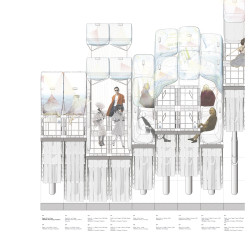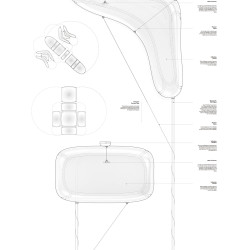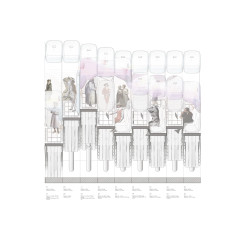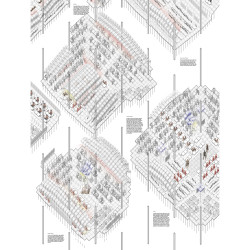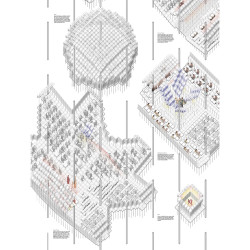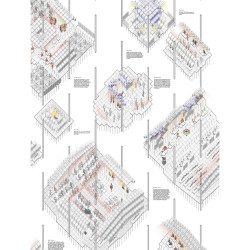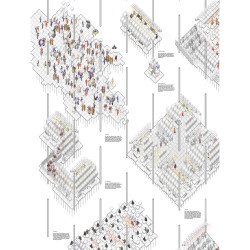Yu Kono . Isabella Marcotulli . David Seung Jun Lee . under the supervision of Urtzi Grau and Guillermo Fernández-Abascal . + Rice School of Architecture
Pixel Explores the possibility of a radically autonomous representative empowered and somehow trapped by the ultimate architectural element of democracy, a technologically enhanced representative s chair in the chambers.
_
I. Democratic Pixel Plan and Personal Services The Democratic Pixel contains a storage units for all personal items that a representative needs to endure a parliamentary session of extended length. Cabinets including water, food, silverware, clothing storage and shoe storage are located below the pixel the representative occupies. Depending on the representative s status, he or she may have access to other storage units easily attainable in adjacent pixels.
II. Democratic Pixel Section and Technical Services
The Democratic Pixel is a piece of technology at the representative s service whose purpose is to receive and disseminate information through multiple media. It includes a built-in tablet, microphones, electrical outlets, and various lighting fixtures. It stages the presence of the representative occupying the Pixel and enhances the performance of the speaker(s) on stage. The Democratic Pixel includes a perimeter LED fixture that illuminates and draws attention towards the representative
addressing the audience. When the pixel is part of a podium, the LED fixtures operate as stage lightings, spotlighting the speaker and adding to the performance s atmosphere.
III. The Democratic Pixel Ceiling, an Inflatable and Self-Deployable Floating Acoustical Shells and Digital Screens
The Democratic Pixel is mechanism that constructs proper visual and acoustical environments for political discussions. Hovering pneumatic acoustic shells adapt to the different configurations of the chambers to provide an homogeneous distribution of sound. Each Pixel includes two types of acoustic cushions. One utilizes its geometry to function as a passive acoustical shell while the other amplifies the sound through electrical means. Each type is deployed according to the chambers configuration. The cushions also include a panoramic projector built inside of the pneumatic shells. The projectors can operate at the scale of the Pixel, as individual screens for the representatives, or collectively, joining to construct massive displays.
IV. The Democratic Pixel Ground, an Inflatable and Self-Deployable Grounded Seats and Walls. The Democratic Pixels can be arranged in different configurations to accommodate the representatives. Several Pixels can join together to form a bench or if a discussion pushes
the limits of comfort, the Pixel can deploy a pneumatic seat. The ergonomic pneumatic seat conforms to the body of the representative for optimal coziness. The Pixel can also deploy half-height walls. These barriers allow smaller discussions to take place within an existing chamber or also provide a backdrop that amplifies the performance.
V. Pixel Democracy, Privacy in an Open System The endless number of possible reconfigurations of the field of Democratic Pixels allow it to host any form of parliamentary activity. From assemblies to private meetings, the system edits itself to create the ideal topography for a discussion of any form or size. At the smallest scale the pixels join to form three main types of spaces for representatives to use. The first one uses the pneumatic walls to create a private research room within an assembly space, allowing for isolation during public meetings. The second, also known as the hallway, allows representatives to casually chat while circulating through different discussions. The last one is the private meeting room. These small scale configurations are never fully isolated spaces, therefore, the field of Democratic Pixels ensures that all governmental conversations are subject to public scrutiny preventing under the table deals.
VI. Sectional Democracy, Impromptu Collaboration
In order to accommodate all types of discussions, the parliament also creates casual spaces for collaboration. The parliament has the capacity to be both transnational and local simultaneously, responding to different cultural traditions. For example, the pixels allow the representatives to make themselves comfortable on an even ground. On the other hand, the open parliament could also generate a highly divisive relationship between the performer and the audience. Hierarchies can be exaggerated through a dramatic sectional difference, creating a space for mandating instead of discussing. Lastly, opposing benches can break down the formality of governmental discussions to make room for informal conversations.
VII. Spectacular Democracy, The Audience Reconfigurations of the Pixel Parliament often take cues from theater design. In traditional theater-like parliament configurations the representatives operate as a passive audience. Inflatable chairs and acoustic cushions are specifically deployed to improve the overall performance of the parliament. Alternatively, a room for circulation can promote casual conversations despite the rigidly traditional theatrical arrangement. similarly a wall of pixels can allow performers to have a secluded backstage to break away from the political performance.
VIII. Directional Democracy, The Performer The reconfigurable system biases theatrical designs as the organizational tool for creating plenary chambers. By openly staging politics, the Pixel Parliament reinforces the role of the representative as an actor standing in place for those he or she represents. To reinforce the hierarchical relationship between the performers and the audience, the field of Pixels can produce an even datum for audience seating. At the same time, the deployment of inflatable walls and canopies distribute sound and visuals evenly, breaking down the scale of large meetings and reinstating a connection between the performer and each audience member.
IX. Traditional Parliaments, Common Typologies
In plan, traditional plenary chambers tend to imitate one of five historical auditorium
typologies: the Arena, the Greek Theater, the Circus Maximus, the Traverse Theater, and the Proscenium Theater. However, their sections often differ from its corresponding theater type and have a tendency to obscure the stage. Leveling the stage obstructs the recognition of the body politic since it inscribes the organizational hierarchy in political discussions. By reinstating sectional gradation to highlight the political stage, the Pixel Parliament emphasizes the performative role of democratic representatives who act in place of their constituents.
X. Aristotelian Theaters, Dramatic Dissemination
Expanding from the five typologies of theaters used in parliamentary design, the Pixel Parliament is reconfigurable to any traditional, experimental and quotidian theater types. This taxonomy focuses on historical performance spaces taking a closer look at the relationship between audience and performers to understand the kinds of conversations these configurations are best suited for. The collection of Aristotelian theaters establish strong hierarchies between audience and performers. In these theater types the performers utilize empathy as the main tool for relaying information in a way telling the audience how to feel rather than asking for critical response. For political discourse, this implies a more totalitarian ruling where presentations are biased over discussion.
XI. Epic Theaters, The Narrative of Knowledge While historical forms have persisted through plenary chamber designs, theater types have been continuously challenged leaving much room for exploration in parliaments. Testing Brechtian principles, this collection highlights the performative components of theatrical spaces. Rather than favoring a holistic escape for the audience to enter the world of the performance, Epic Theater exposes the act by individually breaking down each element. Lighting, sound and performance all work independently causing an alienation of the audience. In this sense, the audience is presented with information and asked to actively make decision for themselves, therefore, creating a space that promotes political discourse amongst the audience.
XII. Political Theaters, Audience as Performer Theater s political role as a space for disseminating information and engaging people into larger political discourse has been clear since as early as Greek and Roman times. However, as Shakespeare stated the world is a stage and performance infiltrates all aspects of public life. This taxonomy explores theatrical spaces that happen outside of the auditorium. Showing
a diverse collection of spaces from parties to catwalks, the inverted hierarchy of audience to performer unifies this collection. In these spaces, the audience is also the performer, creating political stages that fully favor discussion over mandate.
_
Pixel was developed by Yu Kono, Isabella Marcotulli and David Seung Jun Lee.
These proposals for parliaments share a simple ambition: rethink the relation between architecture and political decision making. It is a paradoxical task. Parliaments make puzzling architectural projects in which form and function seem to map each other. As buildings, they host representatives and they represent democracy. And yet form and function never quite align. The aspirational values the building embodies often dissolve in the mundane accomplishments of realpolitik; its administrative functioning appears illegible for those being represented; its symbolic value doesn’t match its everyday functions. This disciplinary disjunction not only brings the parliament to the core of architecture, it also highlights how architecture plays a crucial role in the current crisis of political representation. From the moto ‘they not represent us’ that guided civic uprisings in the south of Europe to the ‘we are the 99%’ of the Occupy Wall Street movement, from the consequences of the Arab Spring to the global rise of right wing populism, events around the world question the validity of traditional modes of representation. In searching for answers to these questions within and without the discipline, parliaments emerge as the ultimate hope for architecture’s relevance. Aware of the futility of extravagant ambitions, these four responses began limiting the scope of the question. To avoid getting entangled in national riddles, these parliaments are designed to govern a region in the making, the Indo Pacific. To escape discussions on the historical value of specific locations, they have no site. To skip default iconicity and semiotic traps, they barely have exteriority. Instead, they focus on the laboratory-like qualities of parliaments. The structural difficulties of bringing facts into politics mirror science’s reluctance to recognize its socially constructed truths. Politicians and scientists are linked by a lack of self-awareness and reciprocal distrust, yet their quarters aren’t so dissimilar. Laboratories and parliaments are insulated interiors where experts represent and discus real-world conditions before their conclusions are released to the public. The institutional protocols, social conventions and technological enablers that govern these institutions vary, but their constituencies aren’t unalike. These projects propose four reorganizations of the networks that connect —and separate— culture and nature. · Standards of Diplomacy, Parliaments for the Indo Pacific Region will be exhibited at The Silos at Sawyer Yards (1502 Sawyer Street, Houston, TX 77007). The show will be held on April 26 to May 1, 2017. The inauguration ceremony will take place from 18h to 21h on Wednesday April 26th. Four projects developed in the Spring of 2017 at the Rice School of Architecture under the supervision of Urtzi Grau and Guillermo Fernández-Abascal by June Deng, Keegan Hebert, Evio Isaac, JP Jackson, Haley Koesters, Yu Kono, Sai Ma, Isabella Marcotulli, Natalia O’Neill Vega, Daria Piekos, Alina Plyusnina and David Seung Jun Lee.

